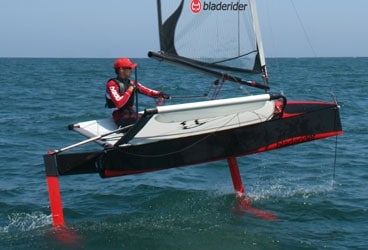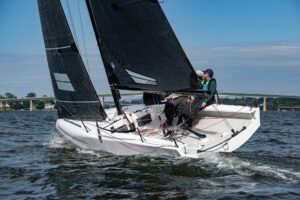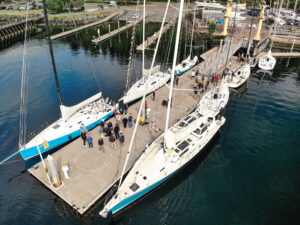
GUMoth368
Even the staunchest keelboat devotee can’t help but be intrigued by them. They don’t have a trapeze, and they’ve only got one little sail, yet they sail at twice the true wind speed. They’re monohulls, but they move faster than a Tornado cat, sailing upwind as fast as 13 knots, downwind close to 30 knots. Jumping out of the water on ultra-light carbon foils in a 5-knot breeze, they’ll smoke almost anything else powered by sails.
They’re International Moths, and if Andrew “Amac” McDougall of Bladerider International has his way, they just may change the world of singlehanded dinghy sailing forever.
Ironically, the Moth class that has spawned the most groundbreaking development in hydrofoil technology is one of the ancient ones. Len Morris built his 11-foot Olive near Melbourne, Australia, in 1928. A year later, Joel Van Sant built a Moth in Elizabeth, New Jersey, to almost the same proportions. In both locations the small catboats were a hit, and numbers grew steadily due to the low cost of building such small, simple dinghies.
The class spread from the U.S. to Europe and from Australia to New Zealand, with huge design variations from fleet to fleet. Various national classes modified their rules slightly to encourage international competition, and with the International Yacht Racing Union’s acceptance of the class in 1972, the International Moth Class was born. The openness of the Class Rule, the first sentence of which reads, “the intention of these class rules is to give the designer and builder the fullest liberty in design and construction,” has resulted in much innovation and a variety of designs, including skiff Moths, pram Moths, scow Moths, skinny tube Moths, dinghy Moths, and now foiling Moths (which can be skiff Moths or scow Moths).
In 1999, Australian Dr. Ian Ward opened a can of worms that would change the class more profoundly than any prior development. Ward fitted horizontal hydrofoils to the bottom of the centerboard and rudder of a Moth and he found that the foils lifted the boat out of the water with ease. Catamaran and trimarans had already proven that three T-shaped foils worked, but conventional wisdom held that a dinghy with two foils would be far too unstable to be sailable. Ward quickly found out that the conventional wisdom was wrong, but devising a system to maintain ride height and control would take more time. Brothers John and Garth Ilett created and refined such a system in 2000 using a surface-sending wand to control the main foil’s lift.
Amidst intense intra-class squabbling, Rohan Veal used the Iletts’ creation to win the 2004 Moth World Championship with eight firsts in eight races. In one race, he beat the second place boat by ten minutes. With non-foiling, or “low riding,” Moths quickly approaching obsolescence, the biggest obstacle to competitive Moth sailors became obtaining their own foiling moths. The Iletts’ Fastacraft and a handful of other small, custom boatbuilders just couldn’t keep up with demand for their carefully constructed, all-carbon dinghies. That’s where McDougall came in.
A longtime Moth sailor, McDougall built his first Moth more than three decades ago. In early 2005, he purchases one of the Iletts’ foiling Moths and immediately knew that it was something special, a sailing experience that shouldn’t be constrained by the limited resources of a few custom builders. McDougall scraped up the money for his own Moth design/build business and set to work improving and simplifying existing designs and components to allow faster fabrication and shorter build times. He spent four months on the design of the foils, performing flow analysis and even writing his own foil-creating software. Once he completed the basic boat design, McDougall recruited Veal to help develop and market the boats, signed a partnership with composite specialist McConaghy Boats, and Bladerider International was born.
There are a handful of foiling Moths in the U.S., but the first two production Bladeriders landed here in April via air freight in boxes weighing about 100 pounds. Detroit sailor Bora Gulari bought the second U.S. boat, and in June he took me out for three days of “flight school.” I came late to sailing and started in big keelboats, so I lack the balance and quick reaction time with which lifelong dinghy sailors are blessed. I weigh around 220 pounds, a third bigger than most competitive Mothies, so in a way, I’m the ideal person to test the Bladerider. McDougall’s vision is not to create one more International Moth, it’s to bring the foiling experience beyond the aerospace engineers and tinkerer/athletes to the average sailor–someone just like me. Twenty minutes on the Bladerider taught me that I’ll never win a Moth World Championship, but I experienced a sensation totally new to me, something that could revolutionize the small boat world.
On the first day, moderate winds on a flat Lake St. Clair provided plenty of power, as Gulari proved less than 20 yards from the entrance to Bayview YC when he launched onto the foils and accelerated to 12 knots, upwind. When he turned down to a reach, our Sea Ray could hardly keep up. After a few minutes, I jumped into the water to take my turn. The first thing that struck me was the boom, in the head. The next was the incredible narrowness of the tiny hull. Dwarfed by large, trampoline-covered carbon wings, the 12-inch wide hull resembles a slab-sided torpedo. The designer realized that the hull would spend most of its time in the air, so he downsized it accordingly. The hull is covered with the most aggressive non-skid I’ve ever encountered, and as tippy as the boat is, that’s a good thing. The racks are works of art: clear-coated carbon sculptures covered with Dacron tramps, their width provides massive righting moment to counter the power from the big, windsurfer-inspired sail that sleeves over a thin-walled carbon mast.
Once I got moving, the instability vanished, even before I lifted free of the water. The foils generate substantial lift and stability at slow speeds, giving the pencil-thin hull the feel of a wide boat. Simple sail controls allowed me to concentrate on placing my body where Gulari told me, although the oversized mainsheet made easing the sail a bit stickier than it should have been. It’s a physical boat that requires lots of balance, and the small loads and efficient controls should be attractive to female and youth sailors.
A puff hit, and I practiced the dinghy mantra, “ease, hike, trim.” Hiking on the wing, I trimmed the sail and lifted almost imperceptibly out of the water. Another puff lifted me completely clear, and things went strangely silent. As a Melges 24 sailor, I’m used to going fast, but that speed is always accompanied by spray, vibration, and the sounds of crashing through waves. Speed on a Moth is completely different–drama free, peaceful, almost trance-inducing. Reality broke into my reverie when I let the boat heel too far to leeward. The boat crashed back into the water, and I hit the shrouds.
For days afterwards, my bruises would remind me of just how fast I’d been going.My test sail was like nothing I’d ever experienced on the water. In twenty minutes, the Bladerider opened my eyes to the possibilities of foilborne sailing. Foils have already invigorated the International Moth Class, with membership growth at a ten-year high, but it’s not just the IMCA that Bladerider is trying to revolutionize. McDougall’s operation currently builds three to four boats per week, but to goal is to double that output.
Priced at $14,000, the Bladerider isn’t cheap, but it provides an utterly new experience. Gliding above the water at double digit speeds, the only sound a faint hiss from the foils, you’ll be transformed. Going back to your loud, sloppy, slow, surface-bound craft might just be unthinkable.
For more about the Bladerider Moth, go to www.bladerider.com.au/









